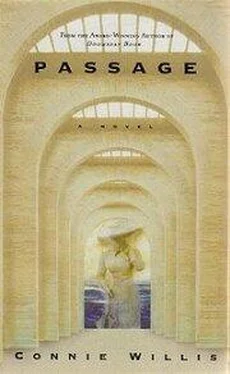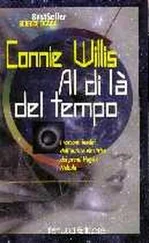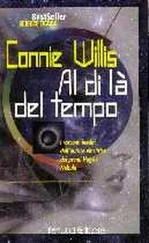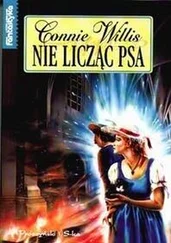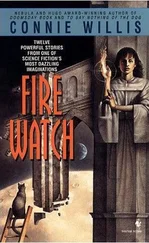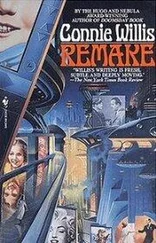“I was not aware of that,” Richard said. “She really goes for the gory details, doesn’t she? Is that what she wanted to see you about?”
“No,” Joanna said. “She found me an account of an NDE connected to the Hindenburg, and I needed to ask her about it. I wanted to know if the account of it was secondhand and if it was written at the time or sometime after.”
“Did Maisie know?”
She shook her head. “Her books didn’t say anything about the circumstances, or the name of the crewman, but she said she’d try to find out.”
“And this NDE was a crewman on the Hindenburg? He coded during the crash and had an NDE?”
“No, a vision,” Joanna said. “He had it while he was hanging on to the metal framework up inside the burning zeppelin.”
“But he saw a tunnel and angels?”
“No, a whale and a birdcage. It doesn’t have any of the standard imagery, but that’s why it’s interesting. It predates Moody and company, so the imagery hasn’t been contaminated, and yet there are definite correspondences to the typical NDE. He hears a sound—the Scream of tearing metal—and sees his grandmother and a dazzling white light that he interprets as snowfields. And there are a number of images that parallel the life review. It could be really useful, but I don’t want to get my hopes up until I know how and when he gave his account. It could all be confabulation, especially if he gave the account several weeks or months after the crash.
“Anyway,” she said, pushing her glasses up on her nose, “getting away from Maisie took a while, and then, as I was on my way here, I saw Mr. Mandrake headed for your lab.”
And you ducked into the nearest stairway, Richard thought. “What did he want?” she asked. “Did he try and pump you about your project?”
“No. He was more interested in telling me why it was doomed to fail.”
“Which speech was it? His ‘Mere science cannot explain the NAE’ speech, his ‘If it looks real, that proves it’s real’ rant, or the ‘more things in heaven and earth’ speech?”
“All of the above,” Richard said. “He told me there were documented cases of people receiving knowledge during NDEs they couldn’t have known otherwise.”
She nodded. “One of the people waiting to greet them is Aunt Ethel, and when they’re revived they call Minnesota and discover that, in fact, Aunt Ethel was just killed in a car accident.”
“So there are cases?”
She shook her head. “Those stories have been around since the days of the Victorian spiritualists, but there’s no documentation. They’re all either thirdhand—somebody knew somebody who told him it had happened to his Aunt Ethel—or the whole thing was conveniently reported after the call from Minnesota reporting the death, and last names are always conveniently left out ‘for the privacy of the subjects,’ so there’s no way to verify or disprove the story. Plus, no one ever bothers to report seeing someone on the Other Side who later turns out not to be dead. Did Mr. Mandrake mention W. T. Stead?”
“No. Who’s that?”
“A famous spiritualist and psychic who wasn’t all that psychic, as it turned out, or he’d never have booked passage on the Titanic. Every other psychic and medium in the business later claimed they’d had visions or premonitions of his death, but not one of them thought to mention it until after the sinking hit the front page, with Stead listed among the lost. And the last person who spoke to Stead reported that when he was told the ship had hit an iceberg, he said, ‘I suppose it’s nothing much.’ ” She frowned. “Mr. Mandrake didn’t ask you about your project?”
“He looked at the RIPT scan and the EEG, but he didn’t ask any questions. Why? Should he have?”
She was still frowning. “He spends half his time snooping around trying to find out who my patients are so he can get to them first. He didn’t ask you anything?”
“No. When he first came in, he said he wanted to discuss the project, but then he launched into how physical explanations couldn’t account for the NDE, and from there to the narrow-mindedness of the scientific establishment. Except for brave pioneers like you and Dr. Seagal.”
“You didn’t tell him we were going to be working together, did you?” Joanna asked.
“No,” he said, trying not to show the sudden uprush of delight he felt. “Are we?”
“Yes,” she said. “Didn’t you get my message?”
“No, my answering machine—”
“Oh, well, I said yes, I’d like to work with you on your project. Actually, I think I said, ‘All right, I’ll do it,’ or something equally cryptic. I left the message last night.”
Not, “Ah, forget it.” “All right.” “Great,” he said, and grinned. “I’m delighted. It’s going to be great working together.”
“I want to keep interviewing patients who come into the hospital, too,” she said, “unless you think that’s a bad idea.”
“No, the more data we have on actual NDEs, the more we’ll be able to tell how ours compare. I only schedule one or two sessions a day, because of the time it takes to analyze the scans. I’m sure we can work around your schedule.”
“I’d appreciate that.”
“Great,” he said. “I’ll talk to the grants office this afternoon about making it official.”
She nodded. “Great. Only don’t tell Mr. Mandrake. The longer we can keep it from him, the less time I’ll have to spend trying to avoid him. So,” she smiled at him, “you want to show me the setup?”
“I’ll do better than that. I’ve got one of my volunteers coming in in about,” he glanced at the clock. A quarter past eleven. “Any time now. In the meantime,” he led her over to the console, “this is the scan console. The images show up here,” he said, pointing to the bank of monitors above the console. “This is the brain in a normal working state,” he said, typing instructions onto the keyboard, and the screen lit up with an orange, yellow, and blue image. He typed some more. “And this is the brain in a REM-sleep dreaming state. See how the prefrontal cortex—that’s the area of waking thought and reality-testing—and the sensory-input areas show almost no activity. And this,” he typed again, “is the brain in an NDE-state, or at least what I hope is an NDE-state.”
Joanna pushed her glasses up on her nose and peered at the screen. “It looks similar to the dream state.”
“Yes, but there’s no activity at all in the prefrontal cortex and increased activity in the anterior lobe, here,” he said, pointing to the red areas, “and in the hippocampus and amygdala.”
“And those are the long-term memories?” she asked, pointing to a scattering of pinpoint red and orange in the frontal cortex.
“Yes.” He blanked out the screens and called up Mr. O’Reirdon’s scan. “This is the template scan,” he said, typing, “and this is the scan from Mr. Wojakowski’s first session.” He superimposed them on a third screen. “You can see the pattern, except for the activity in the frontal cortex, is similar, but not identical. Which is one of the reasons I need you on the project.”
He went over to the scan and put his hand on the arch-shaped dome. “And this is the RIPT scan. The subject ties down here,” he indicated the examining table, “under the scan, and then it’s positioned above the head. The tracer and then a short-term sedative and the dithetamine are fed in through an IV, and blood samples are taken before, during, and after the NDE. I have a nurse assist. I’ve been using a floater.”
Joanna was looking thoughtfully at the arch-shaped opening. “Problem?” Richard asked.
She nodded. “It looks like a tunnel. Is there a way to cover it, put something in front of it till the subject is in place? You want to eliminate any possible physical explanations for the vision.”
Читать дальше
